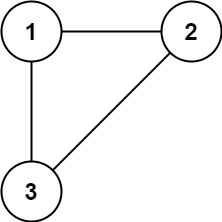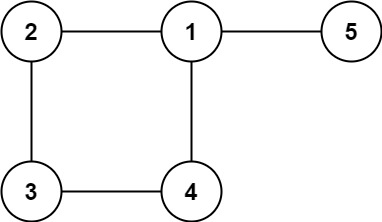684. Redundant Connection¶
Difficulty: Medium
LeetCode Problem View on GitHub
684. Redundant Connection
Medium
In this problem, a tree is an undirected graph that is connected and has no cycles.
You are given a graph that started as a tree with n nodes labeled from 1 to n, with one additional edge added. The added edge has two different vertices chosen from 1 to n, and was not an edge that already existed. The graph is represented as an array edges of length n where edges[i] = [ai, bi] indicates that there is an edge between nodes ai and bi in the graph.
Return an edge that can be removed so that the resulting graph is a tree of n nodes. If there are multiple answers, return the answer that occurs last in the input.
Example 1:

Input: edges = [[1,2],[1,3],[2,3]] Output: [2,3]
Example 2:

Input: edges = [[1,2],[2,3],[3,4],[1,4],[1,5]] Output: [1,4]
Constraints:
n == edges.length3 <= n <= 1000edges[i].length == 21 <= ai < bi <= edges.lengthai != bi- There are no repeated edges.
- The given graph is connected.
Solution¶
class Solution {
private ArrayList<ArrayList<Integer>> adj;
public int[] findRedundantConnection(int[][] edges) {
int n = edges.length;
int ans[] = new int[2];
adj = new ArrayList<>();
for(int i = 0; i <= n + 1; i++) adj.add(new ArrayList<>());
int vis[] = new int[n + 1];
for(int i = 0; i < edges.length; i++) {
adj.get(edges[i][0]).add(edges[i][1]);
adj.get(edges[i][1]).add(edges[i][0]);
Arrays.fill(vis,0);
if(cycle(edges[i][0], -1, vis) == true) return new int[]{edges[i][0], edges[i][1]};
}
return new int[]{0, 0};
}
private boolean cycle(int u, int par, int vis[]) {
vis[u] = 1;
boolean temp = false;
for (int child : adj.get(u)) {
if (vis[child] == 1 && child == par) continue;
if (vis[child] == 1) return true;
temp |= cycle(child, u, vis);
}
return temp;
}
}
Complexity Analysis¶
- Time Complexity:
O(?) - Space Complexity:
O(?)
Approach¶
Detailed explanation of the approach will be added here